2022 TOYOTA SIENNA HYBRID steering wheel
[x] Cancel search: steering wheelPage 2 of 600
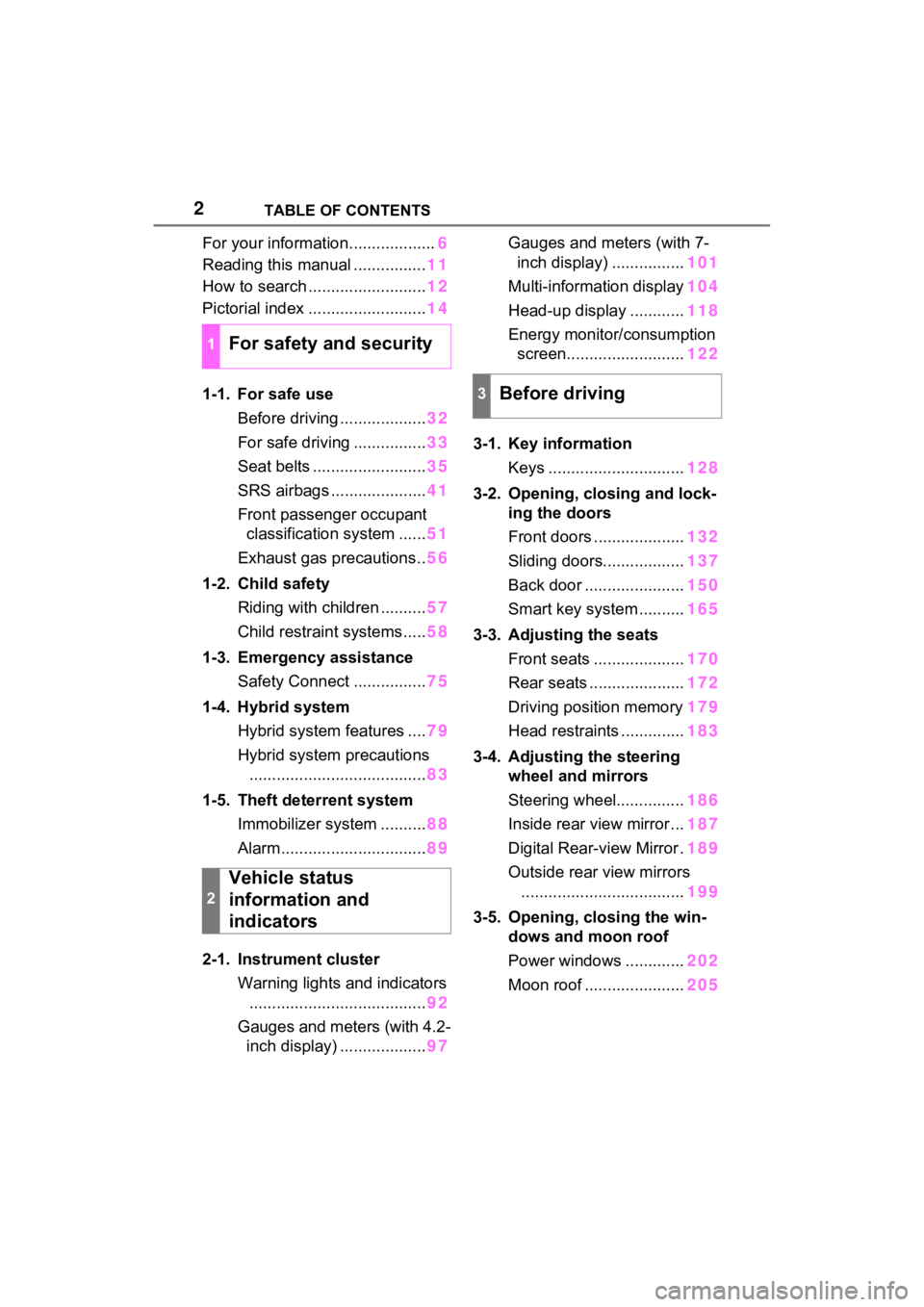
2TABLE OF CONTENTS
For your information...................6
Reading this manual ................ 11
How to search .......................... 12
Pictorial index .......................... 14
1-1. For safe use Before driving ................... 32
For safe driving ................ 33
Seat belts ......................... 35
SRS airbags ..................... 41
Front passenger occupant classification system ...... 51
Exhaust gas precautions.. 56
1-2. Child safety Riding with children .......... 57
Child restraint systems..... 58
1-3. Emergency assistance Safety Connect ................ 75
1-4. Hybrid system Hybrid system features .... 79
Hybrid system precautions ....................................... 83
1-5. Theft deterrent system Immobilizer system .......... 88
Alarm................................ 89
2-1. Instrument cluster Warning lights and indicators....................................... 92
Gauges and meters (with 4.2- inch display) ................... 97Gauges and meters (with 7-
inch display) ................ 101
Multi-information display 104
Head-up display ............ 118
Energy monitor/ consumption
screen.......................... 122
3-1. Key information Keys .............................. 128
3-2. Opening, closing and lock- ing the doors
Front doors .................... 132
Sliding doors.................. 137
Back door ...................... 150
Smart key system .......... 165
3-3. Adjusting the seats Front seats .................... 170
Rear seats ..................... 172
Driving position memory 179
Head restraints .............. 183
3-4. Adjusting the steering wheel and mirrors
Steering wheel............... 186
Inside rear view mirror ... 187
Digital Rear-view Mirror . 189
Outside rear view mirrors .................................... 199
3-5. Opening, closing the win- dows and moon roof
Power windows ............. 202
Moon roof ...................... 205
1For safety and security
2
Vehicle status
information and
indicators
3Before driving
Page 3 of 600
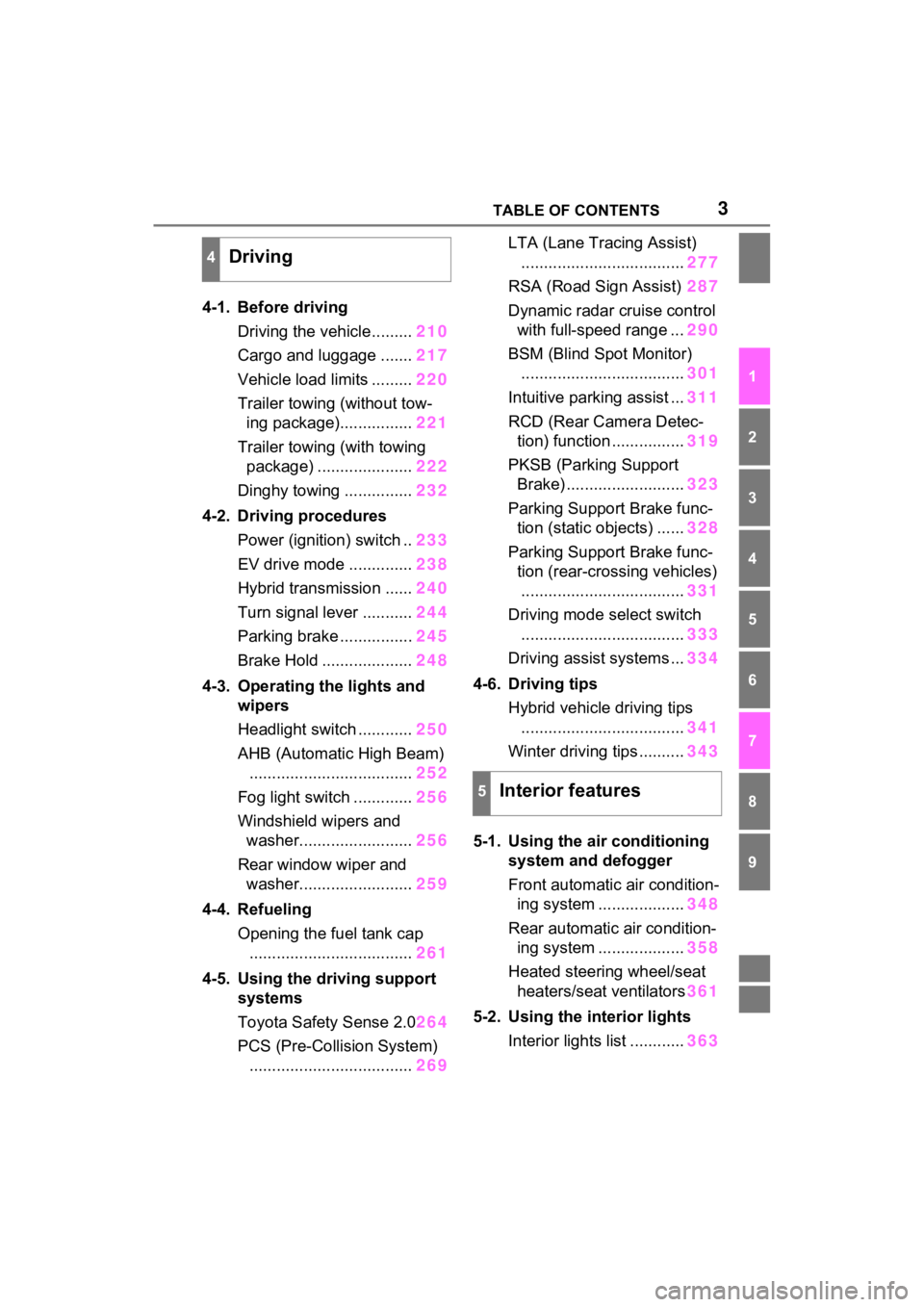
3TABLE OF CONTENTS
1
2
3
4
5
6
7
8
9
4-1. Before drivingDriving the vehicle......... 210
Cargo and luggage ....... 217
Vehicle load limits ......... 220
Trailer towing (without tow- ing package)................ 221
Trailer towing (with towing package) ..................... 222
Dinghy towing ............... 232
4-2. Driving procedures Power (ignition) switch .. 233
EV drive mode .............. 238
Hybrid transmission ...... 240
Turn signal lever ........... 244
Parking brake ................ 245
Brake Hold .................... 248
4-3. Operating the lights and wipers
Headlight switch ............ 250
AHB (Automatic High Beam) .................................... 252
Fog light switch ............. 256
Windshield wipers and washer......................... 256
Rear window wiper and washer......................... 259
4-4. Refueling Opening the fuel tank cap.................................... 261
4-5. Using the driving support
systems
Toyota Safety Sense 2.0 264
PCS (Pre-Collision System) .................................... 269LTA (Lane Tracing Assist)
.................................... 277
RSA (Road Sign Assist) 287
Dynamic radar cruise control with full-speed range ... 290
BSM (Blind Spot Monitor) .................................... 301
Intuitive parking assist ... 311
RCD (Rear Camera Detec- tion) function ................ 319
PKSB (Parking Support Brake) .......................... 323
Parking Support Brake func- tion (static objects) ...... 328
Parking Support Brake func- tion (rear-crossing vehicles).................................... 331
Driving mode s elect switch
.................................... 333
Driving assist systems ... 334
4-6. Driving tips Hybrid vehicle driving tips.................................... 341
Winter driving tips .......... 343
5-1. Using the ai r conditioning
system and defogger
Front automatic air condition- ing system ................... 348
Re ar automatic air condition-
i n
g system ................... 358
Heated steering wheel/seat heaters/seat ventilators 361
5-2. Using the interior lights Interior lights list ............ 363
4Driving
5Interior features
Page 23 of 600
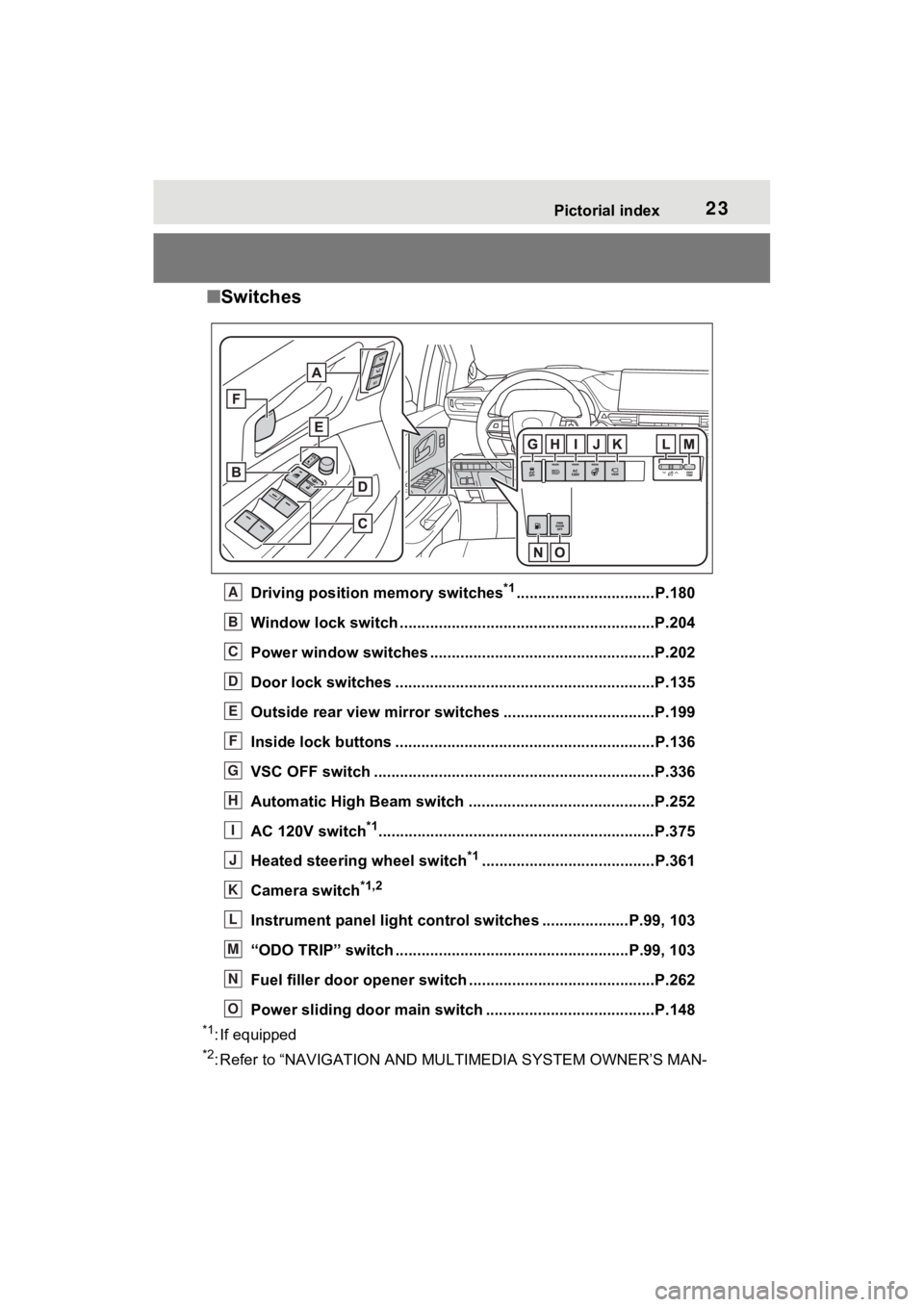
23Pictorial index
■Switches
Driving position memory switches*1................................P.180
Window lock switch ............................................. ..............P.204
Power window switches ....... .............................................P.202
Door lock switches ............................................................P.135
Outside rear view mirror swi tches ...................................P.199
Inside lock buttons ............................................ ................P.136
VSC OFF switch .................................................................P.336
Automatic High Beam switch ..................................... ......P.252
AC 120V switch
*1............................................................... .P.375
Heated steering wheel switch
*1........................................P.361
Camera switch
*1,2
Instrument panel light control switches ....................P.99 , 103
“ODO TRIP” switch .............................................. ........P.99, 103
Fuel filler door opener swi tch ...........................................P.262
Power sliding door main switch ................................. ......P.148
*1: If equipped
*2: Refer to “NAVIGATION AND MULTIMEDIA SYSTEM OWNER’S MAN-
A
B
C
D
E
F
G
H
I
J
K
L
M
N
O
Page 33 of 600
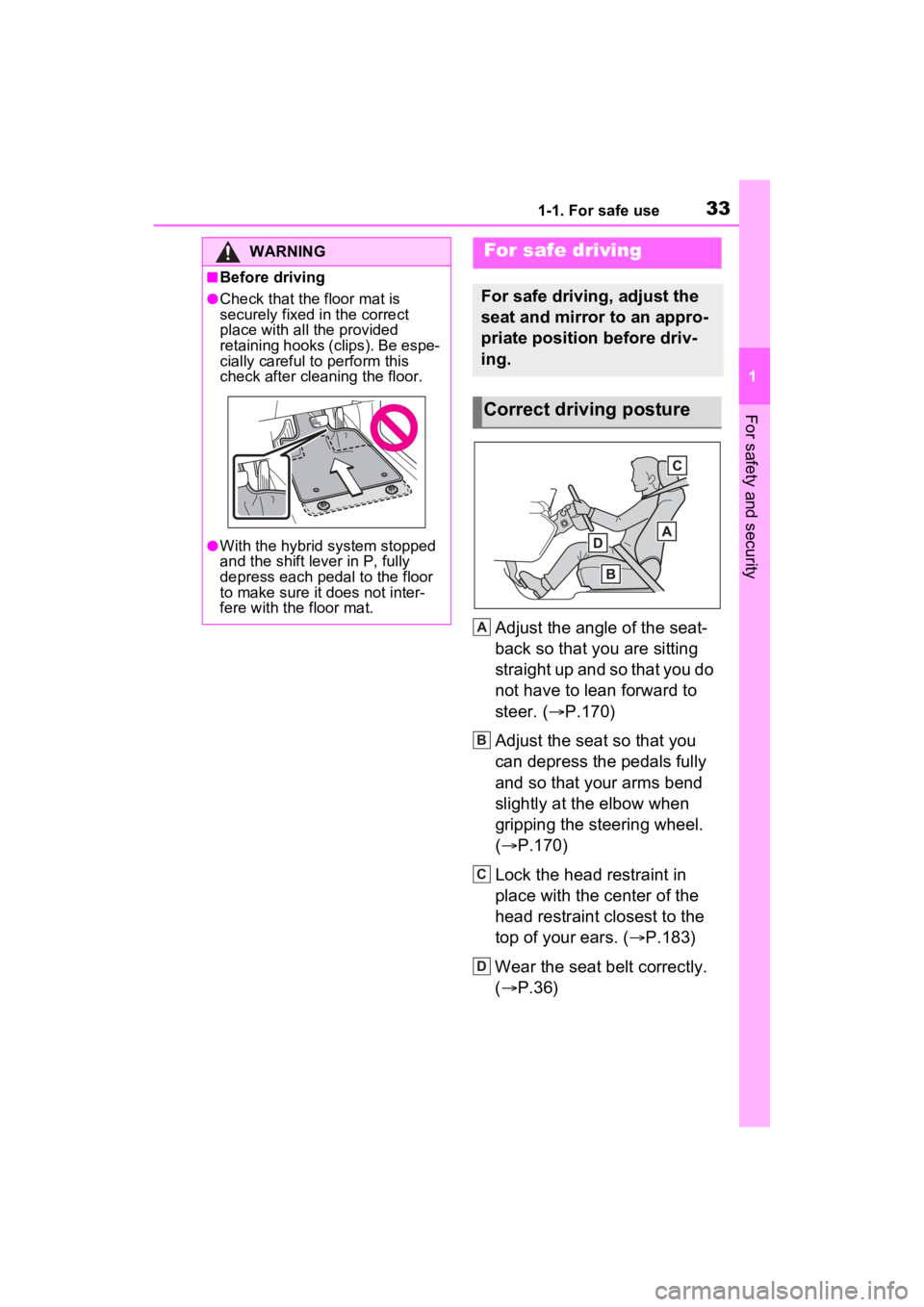
331-1. For safe use
1
For safety and security
Adjust the angle of the seat-
back so that you are sitting
straight up and so that you do
not have to lean forward to
steer. (P.170)
Adjust the seat so that you
can depress the pedals fully
and so that your arms bend
slightly at the elbow when
gripping the steering wheel.
( P.170)
Lock the head restraint in
place with the center of the
head restraint closest to the
top of your ears. ( P.183)
Wear the seat belt correctly.
( P.36)
WARNING
■Before driving
●Check that the floor mat is
securely fixed in the correct
place with all the provided
retaining hooks (clips). Be espe-
cially careful to perform this
check after cleaning the floor.
●With the hybrid system stopped
and the shift lever in P, fully
depress each pedal to the floor
to make sure it does not inter-
fere with the floor mat.
For safe driving
For safe driving, adjust the
seat and mirror to an appro-
priate position before driv-
ing.
Correct driving posture
A
B
C
D
Page 46 of 600
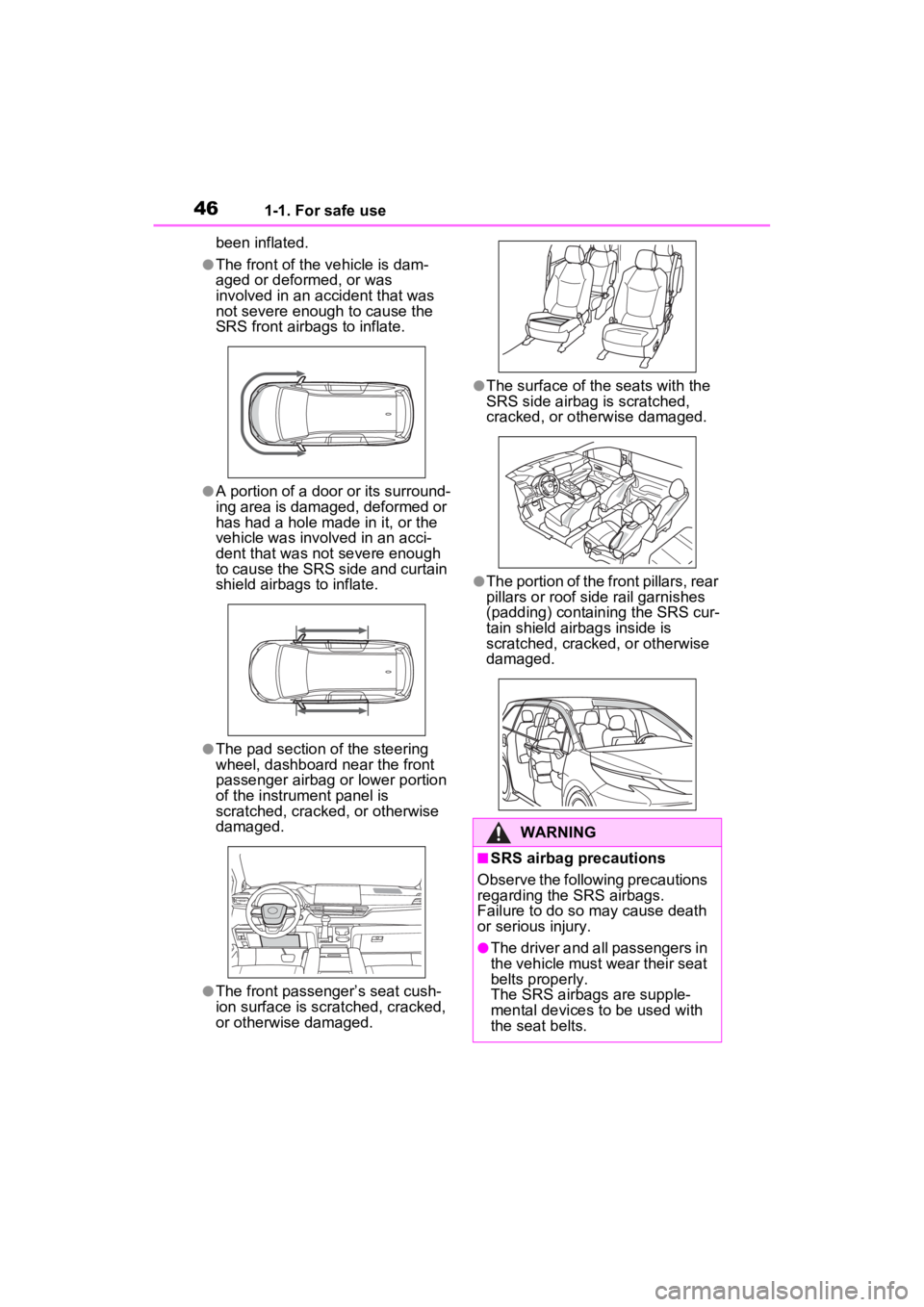
461-1. For safe use
been inflated.
●The front of the vehicle is dam-
aged or deformed, or was
involved in an accident that was
not severe enough to cause the
SRS front airbags to inflate.
●A portion of a door or its surround-
ing area is damaged, deformed or
has had a hole made in it, or the
vehicle was involved in an acci-
dent that was no t severe enough
to cause the SRS side and curtain
shield airbags to inflate.
●The pad section of the steering
wheel, dashboard near the front
passenger airbag o r lower portion
of the instrument panel is
scratched, cracked, or otherwise
damaged.
●The front passenger’s seat cush-
ion surface is scratched, cracked,
or otherwise damaged.
●The surface of the seats with the
SRS side airbag is scratched,
cracked, or otherwise damaged.
●The portion of the front pillars, rear
pillars or roof side rail garnishes
(padding) containing the SRS cur-
tain shield airbags inside is
scratched, cracked, or otherwise
damaged.
WARNING
■SRS airbag precautions
Observe the following precautions
regarding the SRS airbags.
Failure to do so may cause death
or serious injury.
●The driver and all passengers in
the vehicle must wear their seat
belts properly.
The SRS airbags are supple-
mental devices to be used with
the seat belts.
Page 47 of 600
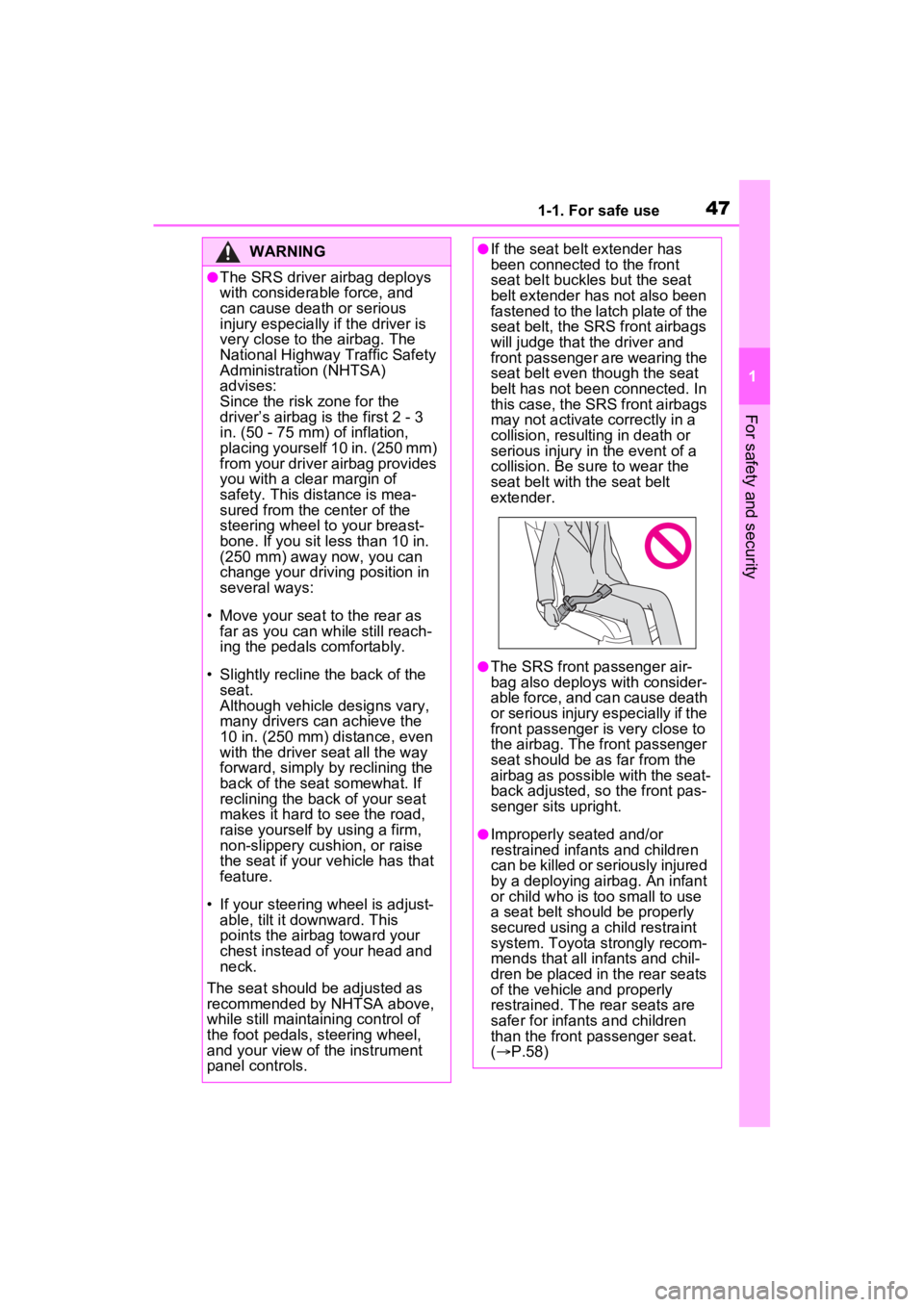
471-1. For safe use
1
For safety and security
WARNING
●The SRS driver airbag deploys
with considerable force, and
can cause death or serious
injury especially i f the driver is
very close to the airbag. The
National Highway Traffic Safety
Administration (NHTSA)
advises:
Since the risk zone for the
driver’s airbag is the first 2 - 3
in. (50 - 75 mm) of inflation,
placing yourself 10 in. (250 mm)
from your driver airbag provides
you with a clear margin of
safety. This distance is mea-
sured from the center of the
steering wheel to your breast-
bone. If you sit less than 10 in.
(250 mm) away now, you can
change your driving position in
several ways:
• Move your seat to the rear as far as you can while still reach-
ing the pedals comfortably.
• Slightly recline the back of the seat.
Although vehicle designs vary,
many drivers can achieve the
10 in. (250 mm) distance, even
with the driver seat all the way
forward, simply by reclining the
back of the seat somewhat. If
reclining the back of your seat
makes it hard to see the road,
raise yourself by using a firm,
non-slippery cushion, or raise
the seat if your vehicle has that
feature.
• If your steering wheel is adjust- able, tilt it downward. This
points the airbag toward your
chest instead of your head and
neck.
The seat should be adjusted as
recommended by NHTSA above,
while still maintaining control of
the foot pedals, steering wheel,
and your view of the instrument
panel controls.
●If the seat belt extender has
been connected to the front
seat belt buckles but the seat
belt extender has not also been
fastened to the latch plate of the
seat belt, the SRS front airbags
will judge that the driver and
front passenger are wearing the
seat belt even though the seat
belt has not been connected. In
this case, the SRS front airbags
may not activate correctly in a
collision, resulting in death or
serious injury in the event of a
collision. Be su re to wear the
seat belt with the seat belt
extender.
●The SRS front passenger air-
bag also deploys with consider-
able force, and can cause death
or serious injury especially if the
front passenger is very close to
the airbag. The front passenger
seat should be as far from the
airbag as possible with the seat-
back adjusted, so the front pas-
senger sits upright.
●Improperly seated and/or
restrained infants and children
can be killed or seriously injured
by a deploying airbag. An infant
or child who is too small to use
a seat belt should be properly
secured using a child restraint
system. Toyota strongly recom-
mends that all infants and chil-
dren be placed in the rear seats
of the vehicle and properly
restrained. The rear seats are
safer for infants and children
than the front passenger seat.
( P.58)
Page 48 of 600

481-1. For safe use
WARNING
●Do not sit on the edge of the
seat or lean against the dash-
board.
●Do not allow a child to stand in
front of the SRS front passenger
airbag unit or sit on the knees of
a front passenger.
●Do not allow the front seat occu-
pants to hold items on their
knees.
●Do not lean against the door,
the roof side rail or the front,
side and rear pillars.
●Do not allow anyone to kneel on
the passenger seats toward the
door or put their head or hands
outside the vehicle.
●Do not attach anything to or
lean anything against areas
such as the dashboard, steering
wheel pad and lower portion of
the instrument panel.
These items can become pro-
jectiles when the SRS driver,
front passenger and driver’s
knee airbags deploy.
●Do not attach anything to areas
such as a door, windshield, side
windows, front or rear pillar, roof
side rail and assist grip. (Except
for the speed limit label
P.482)
Page 49 of 600
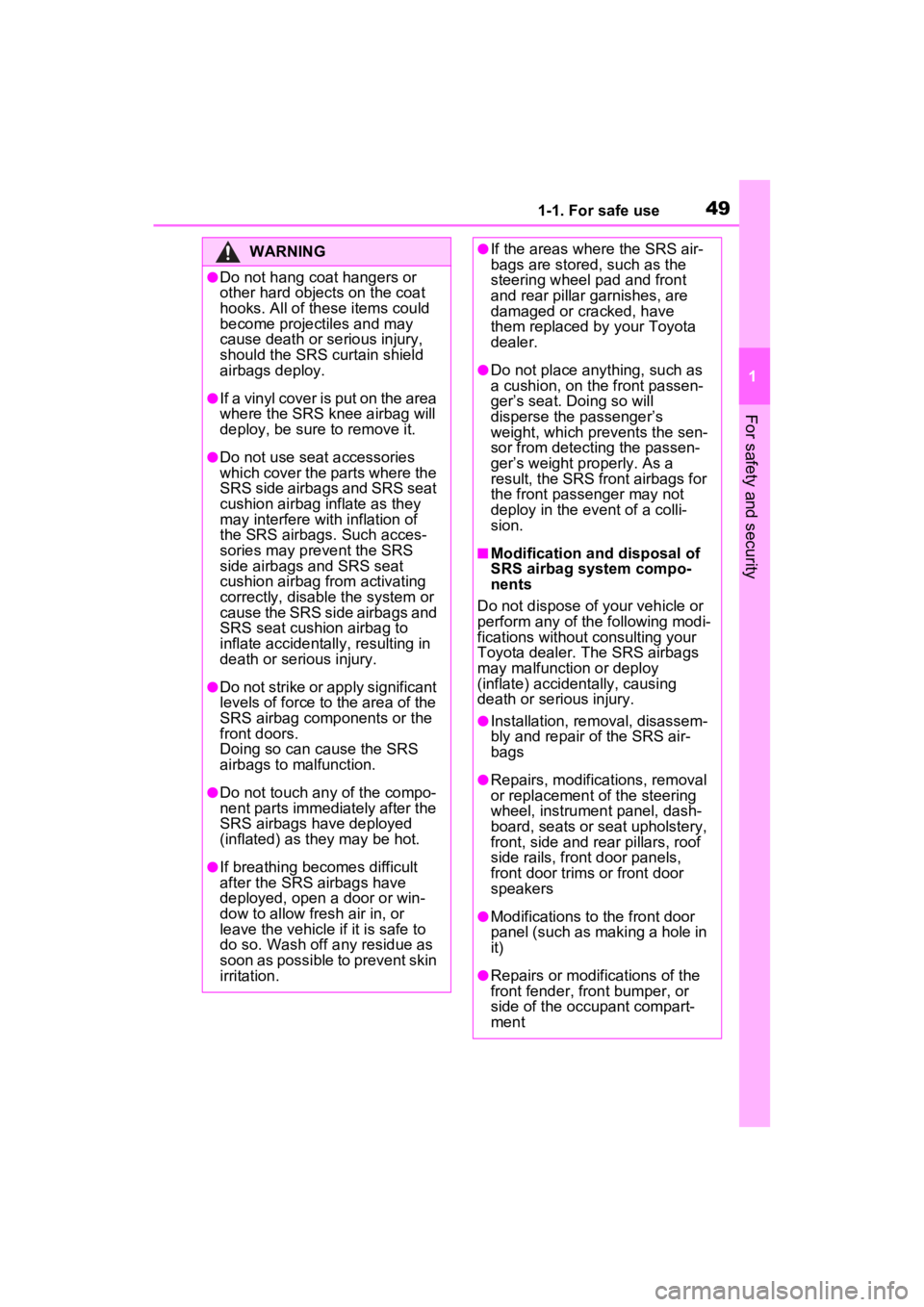
491-1. For safe use
1
For safety and security
WARNING
●Do not hang coat hangers or
other hard objects on the coat
hooks. All of these items could
become projectiles and may
cause death or serious injury,
should the SRS curtain shield
airbags deploy.
●If a vinyl cover is put on the area
where the SRS knee airbag will
deploy, be sure to remove it.
●Do not use seat accessories
which cover the parts where the
SRS side airbags and SRS seat
cushion airbag inflate as they
may interfere with inflation of
the SRS airbags. Such acces-
sories may prevent the SRS
side airbags and SRS seat
cushion airbag from activating
correctly, disable the system or
cause the SRS side airbags and
SRS seat cushion airbag to
inflate accidentally, resulting in
death or serious injury.
●Do not strike or apply significant
levels of force to the area of the
SRS airbag components or the
front doors.
Doing so can cause the SRS
airbags to malfunction.
●Do not touch any of the compo-
nent parts immediately after the
SRS airbags have deployed
(inflated) as they may be hot.
●If breathing becomes difficult
after the SRS airbags have
deployed, open a door or win-
dow to allow fresh air in, or
leave the vehicle if it is safe to
do so. Wash off any residue as
soon as possible to prevent skin
irritation.
●If the areas where the SRS air-
bags are stored, such as the
steering wheel pad and front
and rear pillar garnishes, are
damaged or cracked, have
them replaced by your Toyota
dealer.
●Do not place anything, such as
a cushion, on the front passen-
ger’s seat. Doing so will
disperse the passenger’s
weight, which prevents the sen-
sor from detecting the passen-
ger’s weight properly. As a
result, the SRS front airbags for
the front passenger may not
deploy in the event of a colli-
sion.
■Modification and disposal of
SRS airbag system compo-
nents
Do not dispose of your vehicle or
perform any of the following modi-
fications without consulting your
Toyota dealer. The SRS airbags
may malfunction or deploy
(inflate) accidentally, causing
death or serious injury.
●Installation, re moval, disassem-
bly and repair of the SRS air-
bags
●Repairs, modific ations, removal
or replacement of the steering
wheel, instrument panel, dash-
board, seats or seat upholstery,
front, side and rear pillars, roof
side rails, front door panels,
front door trims or front door
speakers
●Modifications to the front door
panel (such as making a hole in
it)
●Repairs or modifications of the
front fender, fr ont bumper, or
side of the occupant compart-
ment